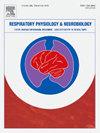Spirometric and exercise ventilatory predictors of expiratory flow-limitation in adults with normal and mildly-obstructed airways
IF 1.6
4区 医学
Q3 PHYSIOLOGY
引用次数: 0
Abstract
Purpose
We determined the resting spirometric and exercise ventilatory variables that are predictive of exercise expiratory flow limitation (EFL) in a group of adults in whom airway function varied from mildly obstructed to above predicted values.
Methods
We studied n = 25 adults (16/9 M/F; age, 31 years) in whom forced expiratory volume in 1 s (FEV1) ranged from 63 % to 149 %-predicted. Subjects completed an incremental exercise test. Tidal expiratory flow-volume (TEFV) curves were placed within the maximal expiratory flow-volume (MEFV) curve and %-EFL was determined based on the overlap between the TEFV and MEFV curves. Multivariate linear (MRlin) and logistic regression (MRlog) were performed using spirometric and exercise measurements as predictor variables and the presence and magnitude of EFL as the outcome variable.
Results
A set of spirometric variables explained 75 % and 73 % of the variance in %-EFL and the presence of EFL using MRlin and MRlog, respectively. A set of inputs consisting of both spirometric and exercise ventilatory variables improved the predictive ability of the models. Backward stepwise modeling, using both MRlin and MRlog, resulted in a total of seven final variables in both analyses. The final variables represented a combination of spirometric and exercise ventilatory inputs, and R2 values of 0.93 and 1.00 for MRlin and MRlog.
Conclusions
Given the difficulty of measuring EFL during exercise, our findings suggest that integrating additional measurements reflecting ventilatory capacity (i.e., spirometry) and demand (exercise measurements), including dynamic operating lung volumes, in clinical exercise testing will improve assessment of exercise ventilatory constraint.
正常和轻度气道阻塞成人呼气流量受限的肺活量测定和运动通气预测指标。
目的:在一组气道功能从轻度阻塞到高于预测值的成人中,我们确定了预测运动性呼气流量限制(EFL)的静息肺活量和运动通气变量。方法:我们研究了n=25名成人(16/9M/F;年龄,31岁),其中15秒用力呼气量(FEV1)范围为63%至149%-预测。受试者完成了一项增量运动测试。将潮汐呼气流量-容积(TEFV)曲线置于最大呼气流量-容积(MEFV)曲线内,根据TEFV曲线与MEFV曲线的重叠度确定%-EFL。多变量线性回归(MRlin)和逻辑回归(MRlog)使用肺活量和运动测量作为预测变量,EFL的存在和程度作为结果变量。结果:一组肺活量测量变量分别用MRlin和MRlog解释了%-EFL和EFL存在的75%和73%的方差。一组由肺活量测定和运动通气变量组成的输入提高了模型的预测能力。使用MRlin和MRlog的后向逐步建模在两种分析中总共产生了7个最终变量。最终变量代表肺活量测定和运动通气输入的组合,MRlin和MRlog的R2值分别为0.93和1.00。结论:考虑到在运动过程中测量EFL的难度,我们的研究结果表明,在临床运动测试中整合反映通气量(即肺活量测定法)和需求(运动测量法)的额外测量,包括动态操作肺容量,将改善对运动通气约束的评估。
本文章由计算机程序翻译,如有差异,请以英文原文为准。
求助全文
约1分钟内获得全文
求助全文
来源期刊
CiteScore
4.80
自引率
8.70%
发文量
104
审稿时长
54 days
期刊介绍:
Respiratory Physiology & Neurobiology (RESPNB) publishes original articles and invited reviews concerning physiology and pathophysiology of respiration in its broadest sense.
Although a special focus is on topics in neurobiology, high quality papers in respiratory molecular and cellular biology are also welcome, as are high-quality papers in traditional areas, such as:
-Mechanics of breathing-
Gas exchange and acid-base balance-
Respiration at rest and exercise-
Respiration in unusual conditions, like high or low pressure or changes of temperature, low ambient oxygen-
Embryonic and adult respiration-
Comparative respiratory physiology.
Papers on clinical aspects, original methods, as well as theoretical papers are also considered as long as they foster the understanding of respiratory physiology and pathophysiology.

 求助内容:
求助内容: 应助结果提醒方式:
应助结果提醒方式:


